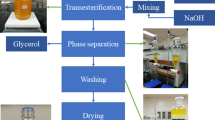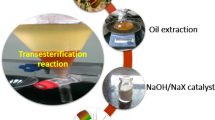Abstract
The short supply of edible vegetable oils is the limiting factor in the progression of biodiesel technology; thus, in this study, we applied response surface methodology in order to optimize the reaction factors for biodiesel synthesis from inedible castor oil. Specifically, we evaluated the effects of multiple parameters and their reciprocal interactions using a five-level three-factor design. In a total of 20 individual experiments, we optimized the reaction temperature, oil-to-methanol molar ratio, and quantity of catalyst. Our model equation predicted that the following conditions would generate the maximum quantity of castor biodiesel (92 wt.%): a 40-min reaction at 35.5 °C, with an oil-to-methanol molar ratio of 1:8.24, and a catalyst concentration of 1.45% of KOH by weight of castor oil. Subsequent empirical analyses of the biodiesel generated under the predicted conditions showed that the model equation accurately predicted castor biodiesel yields within the tested ranges. The biodiesel produced from castor oil satisfied the relevant quality standards without regard to viscosity and cold filter plugging point.






Similar content being viewed by others
References
Mittelbach, M., & Remschmidt, C. (2004). Biodiesel—the comprehensive handbook (1st ed.). Austria: Boersedruck Ges.m.b.H.
Kim, H. R. (2002). Prospectives of Industrial Chemistry, 5, 27–34.
Jeong, G. T., & Park, D. H. (2006). Applied Biochemistry and Biotechnology, 129–132, 668–679. doi:10.1385/ABAB:131:1:668.
Park, J. Y., Kim, D. K., Wang, Z. M., Lu, P., Park, S. C., & Lee, J. S. (2008). Applied Biochemistry and Biotechnology, 148, 109–117. doi:10.1007/s12010-007-8082-2.
Lang, X., Dalai, A. K., Bakhshi, N. N., Reaney, M. J., & Hertz, P. B. (2001). Bioresource Technology, 80, 53–62. doi:10.1016/S0960-8524(01)00051-7.
Ma, F., & Hanna, M. A. (1999). Bioresource Technology, 70, 1–15. doi:10.1016/S0960-8524(99)00025-5.
Graboski, M. S., & McCormick, R. L. (1998). Progress in Energy and Combustion Science, 24, 125–164. doi:10.1016/S0360-1285(97)00034-8.
Jeong, G. T., Oh, Y. T., & Park, D. H. (2006). Applied Biochemistry and Biotechnology, 129–132, 165–178. doi:10.1385/ABAB:129:1:165.
Scholz, V., & Silva, J. N. (2007). Prospects and risks of the use of castor oil as a fuel. Biomass and Bioenergy, 32, 95–100. doi:10.1016/j.biombioe.2007.08.004.
Ogunniyi, D. S. (2006). Bioresource Technology, 97, 1086–1091. doi:10.1016/j.biortech.2005.03.028.
Meneghetti, S. M. P., Meneghetti, M. R., Wolf, C. R., Silva, E. C., Lima, G. E. S., Silva, L. L., et al. (2006). Energy & Fuels, 20, 2262–2265. doi:10.1021/ef060118m.
Silva, N. D. L. D., Maciel, M. R. W. M., Batistella, C. B., & Filho, R. M. (2006). Applied Biochemistry and Biotechnology, 129–132, 405–414. doi:10.1385/ABAB:130:1:405.
Oliveira, D., Luccio, M. D., Faccio, C., Rosa, C. D., Bender, J. P., Lipke, N., et al. (2005). Applied Biochemistry and Biotechnology, 121–124, 553–560. doi:10.1385/ABAB:122:1-3:0553.
Meneghetti, S. M. P., Meneghetti, M. R., Serra, T. M., Barbosa, D. C., & Wolf, C. R. (2007). Energy & Fuels, 21(6), 3746–3747. doi:10.1021/ef070039q.
Varma, M. N., & Madras, G. (2007). Industrial & Engineering Chemistry Research, 46(1), 1–6. doi:10.1021/ie0607043.
Jeong, G. T., Kim, D. H., & Park, D. H. (2007). Applied Biochemistry and Biotechnology, 136–140, 583–594. doi:10.1007/s12010-007-9081-z.
Jeong, G. T., Yang, H. S., & Park, D. H. (2009). Bioresource Technology, 100, 25–30. doi:10.1016/j.biortech.2008.05.011.
Freedman, B., Pryde, E. H., & Mounts, T. L. (1984). Journal of the American Oil Chemists' Society, 61, 1683–1643.
Vicente, G., Coteron, M., Martinez, M., & Aracil, J. (1998). Industrial Crops and Products, 8, 29–35. doi:10.1016/S0926-6690(97)10003-6.
Shieh, C. J., Liao, H. F., & Lee, C. C. (2003). Bioresource Technology, 88, 103–106. doi:10.1016/S0960-8524(02)00292-4.
Shaw, J. F., Wu, H. Z., & Shieh, C. J. (2003). Food Chemistry, 81, 91–96. doi:10.1016/S0308-8146(02)00383-7.
Korean Standard Association (2003). Animal and vegetable fats and oils analysis by gas chromatography of methyl esters of fatty acids (KS H ISO 5508). Geneva: ISO.
Acknowledgments
This work is an outcome of the fostering project of the Specialized Graduate School, which is supported financially by the Ministry of Knowledge Economy.
Author information
Authors and Affiliations
Corresponding author
Rights and permissions
About this article
Cite this article
Jeong, GT., Park, DH. Optimization of Biodiesel Production from Castor Oil Using Response Surface Methodology. Appl Biochem Biotechnol 156, 1–11 (2009). https://doi.org/10.1007/s12010-008-8468-9
Received:
Accepted:
Published:
Issue Date:
DOI: https://doi.org/10.1007/s12010-008-8468-9




